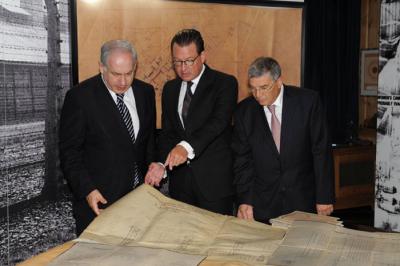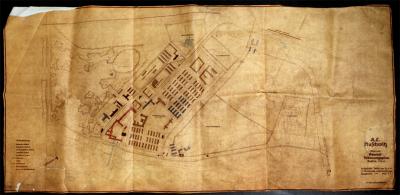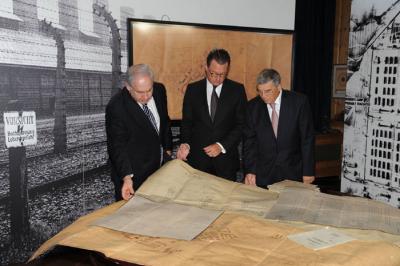27 August 2009
On Thursday, August 27, 2009, at a special ceremony in Berlin, the German newspaper Bild presented original architectural plans of the Auschwitz-Birkenau camp to Prime Minister Benjamin Netanyahu, for safekeeping at Yad Vashem. Yad Vashem Chairman Avner Shalev and Director of the Yad Vashem Archives Haim Gertner participated in the event.
Shortly after the blueprints were uncovered in 2008, the editor in chief of Bild, Kai Diekmann, decided that Yad Vashem was the most appropriate venue for their safekeeping. The plans will be displayed at Yad Vashem in January 2010, marking 65 years since the liberation of Auschwitz.
“As original plans detailing the construction of Auschwitz, where some 1.1 million Jews were murdered, these documents have great historical significance,” said Shalev. “They constitute concrete illustration of the Germans’ systematic effort to carry out the ‘Final Solution’. The decision of Mr. Diekman, and the leadership of the Bild, to ensure their preservation at Yad Vashem carries special significance. Here, on the Mt. of Remembrance in Jerusalem, they will be available to researchers for years to come.”
The collection consists of 29 documents. Architectural plans, drawn on a scale of 1:100, show details for expanding the camp, including the addition of a crematorium and a gas chamber. They are dated between 1941 and 1943, and have been authenticated by experts from Germany's Federal Archives. Discovered last year in Berlin, and acquired by the German newspaper Bild, the sketches include plans for a purification building, with a gas chamber, dated 8 November 1941 (the building was never built); Crematorium II + III from November 1941; a plan for a building to contain corpses; a two-dimensional sketch of the now-iconic entry way to the Birkenau death camp; a sketch from 30 April 1942 for plans to expand Auschwitz I (plans which were partially completed); an initial plan for Birkenau from October 1941; and a plan for a huge headquarters building (dated 17 December 1941), that was never carried out. Some of the documents bear notes in the margins, or signatures by senior Nazis, including Himmler. Copies of some of these documents exist in other archives, and were previously known, but as a whole these are significant historical records.
The documents will be housed in the Yad Vashem Archives, which currently holds over 125 million pages of documentation about the Holocaust.









